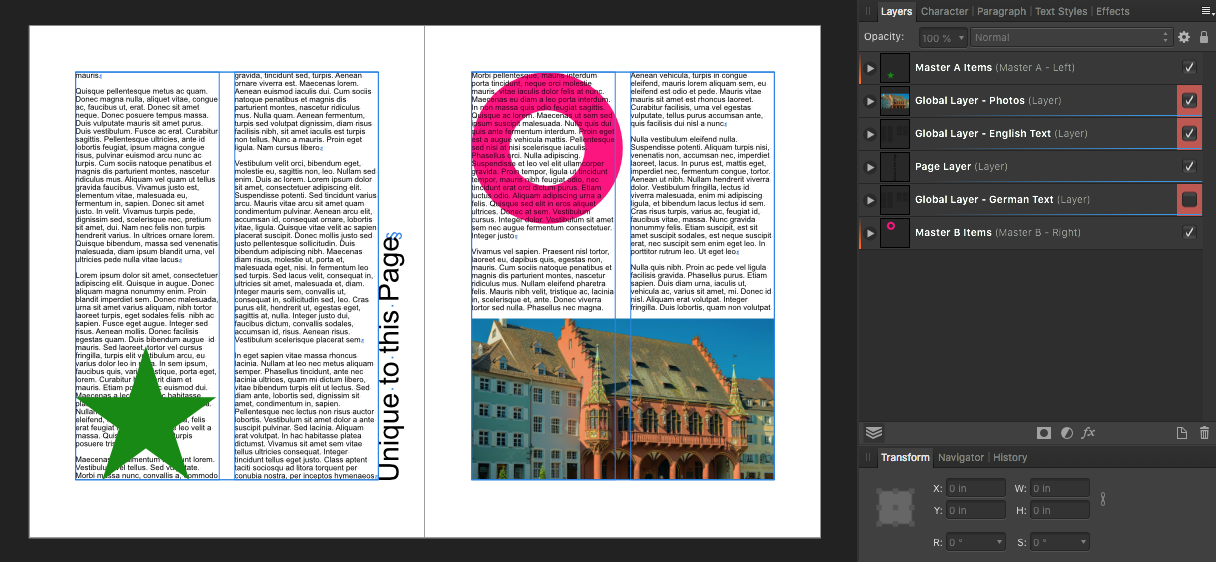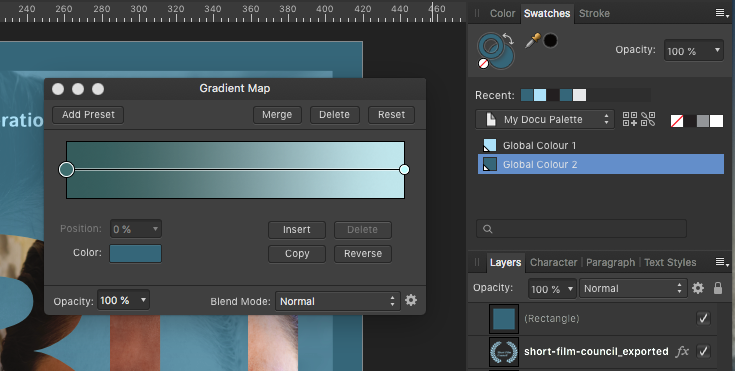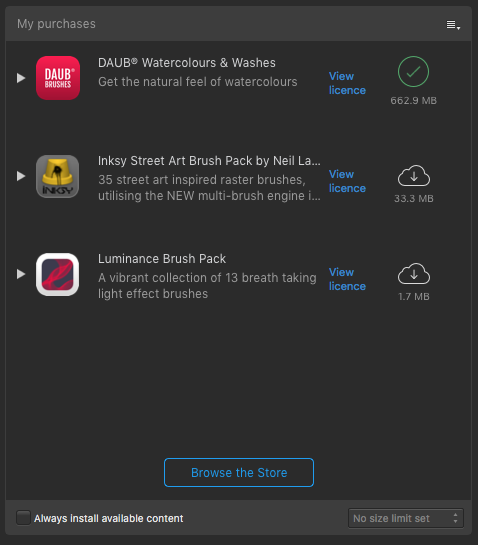
Mark Oehlschlager
-
Posts
634 -
Joined
-
Last visited
Posts posted by Mark Oehlschlager
-
-
12 minutes ago, Jeremy Bohn said:
Adobe apps go a step further and actually require that objects be bound to a layer, but I don't think it's necessary.
This is an aspect of the Adobe model that can be restrictive. On occasion, I've wanted to add a page specific item to a document that didn't really conform to the Global Layer stack schema, and then one is forced to either add the item to an existing Global Layer, or to introduce a new Global Layer for that one, page-specific item.
I think a case can be made for the existence of both "Page Layers" and "Global Layers" created and managed from within the Layers Panel.
-
Presently, one can add empty container layers (i.e., not object or text layers) from the Layers Panel, but these layers are properties of individual pages. Would it be possible (without mucking up the architecture of the Affinity Suite) to be able to add document-wide Global Layers from the Layers Panel?
In this conception, Master Pages would offer repeatable but page-specific page composition schemas (not necessarily applied continuously or document-wide), Layers (as currently defined, and what might be called Page Layers) would offer Page-specific object containers, and Global Layers would offer document-wide containers for organizing types of content that need to be switched on/off globally (e.g., alternate texts in a multi-lingual document).
Global Layers would always preserve their stacking order relative to each other, but otherwise, for each spread, the user could freely arrange the stacking order of applied Master Pages, Page Layers, and Global Layers.
See screenshot illustration below.
-
The chief use case for Global Layers is setting up multi-lingual documents, where each global layer carries the text of one language and the visibility of the language layers can be turned on or off. Can this even be achieved using master pages in Publisher? I don't think that one can toggle the visibility of master pages on/off globally with one click.
As far as I can tell, Publisher would require one to set a publication in Language 01 (e.g., English), then duplicate the finished document and replace all the threaded Language 01 stories with Language 02 translations, and make final copy fitting adjustments.
-
Allow me to add an addendum to the list of feature requests:
-
Sort out the inconsistent UX behaviors when selecting a swatch from any of the Pantone swatch libraries, and give the user control over to which user defined palette a Pantone swatch should be copied. Presently, this is what happens:
- When a user clicks on a swatch from a Pantone color swatch library for the first time – even when the user has created one or more named document color palettes (e.g., Primary Colors, Secondary Colors, Accent Colors) – the Affinity application will automatically generate a new document color palette titled "Document" and place a copy of the Pantone swatch there rather than ask the user where he/she would like to place the copy of the Pantone color swatch.
- Subsequently, when a user clicks on additional swatches from a Pantone color swatch library, a copy of that color swatch is not placed in any document color palette – neither the user defined document color palettes, nor the auto-generated document palette titled "Document". The Pantone color simply fills the color well above, requiring the user to then switch palettes and to use one of the "Add color to ..." buttons to add the color swatch to a palette.
-
Give the user the ability to copy / move a color swatch from one palette to another.
- If I have two or more user defined palettes (e.g., Primary Colors, Secondary Colors, Accent Colors), I want a convenient way to right click on a color swatch in one palette and choose a command to move or copy that color swatch to another user defined palette.
- Presently, one has to do this in three to five steps: 1) select swatch in Palette 01 to fill color well; 2) switch color palette selection to Palette 02; 3) click one of the two "Add color to ..." buttons to add the color swatch to Palette 02; 4) switch the color palette selection back to Palette 01; 5) right-click on the original color swatch to delete it from Palette 01.
-
Give the user the ability to duplicate and reclassify a user generated palette from one type to another (Document / Application / System).
- Presently, the only way to manage this is a multi-step process: 1) export the user defined Application Palette, "My Colors"; 2) import the exported "My Colors" color palette file as a Document Palette; 3) delete the original "My Colors" Application Palette.
There is a ton of room for innovation and improvement with regard to color palette building, selection and management. I would encourage the development team to take this on as a project. Start thinking through the problem of creating and curating project color palettes as a designer or artist would. Make the tools and interface support a creative, intuitive and frictionless work experience.
Thank you.
-
Sort out the inconsistent UX behaviors when selecting a swatch from any of the Pantone swatch libraries, and give the user control over to which user defined palette a Pantone swatch should be copied. Presently, this is what happens:
-
Bumping this because it's still relevant.
And I would add the following:
- the UX behavior for any "new item" command (e.g., new swatch, new palette, new spare channel, etc.) should automatically present a naming dialogue box so that one can create and name the new item in one fluid motion.
- double clicking a color swatch to edit its properties should allow one the opportunity to change all properties (color model, color numbers, spot vs. process, overprint vs knockout)
- when a color swatch is defined as a spot color, and/or as an overprinted color, the symbolic swatch markings that indicate spot and overprint should display wherever in the interface that the swatch palette is presented (i.e., not just in the main swatch panel, but also in all of the contextual presentations of the swatch panel, like the tool bar and all of the adjustment and effects layers.
-
I'm running Mac OS High Sierra 10.13.6, so the Windows beta won't work for me.
-
Quick report that the latest beta for Affinity Photo (1.9.1.219) crashes upon launch.
-
Clearly an oversight on the Mac side. This is the hazard of trying to develop software for multiple OS platforms.
-
One of the supposed new features of Designer 1.9.0 is the ability to customize the color of the bleed guides. You're supposed to be able to see a color chip under the Bleed tab in the Document Setup dialog box, but I don't see such a color chip on the Bleed tab.
Am I missing something, or is this a bug?
I'm running on OS X High Sierra.
-
Not sure whether or not this has been reported, but the tiny icon problem is present in the Color and Swatch panels as well.
See the "No Color", "Switch Colors", and "Eyedropper" icons in the screenshot below.
-
I just discovered the "Delete Segment" option added to the Node tool. For those who don't know, Control-clicking on a curve segment with the Node Tool will now delete that segment with one click.
Great addition. So much more efficient than having to break a curve at two points before eliminating a curve segment.
Thank you.
-
I hear the top Russiagater narrating your demo video.
-
-
-
This remains a problem in Beta 1.9.0.887.
-
I just tried exporting an Affinity Designer document with a two-word headline to PDF, EPS, and SVG.
In my experience, the SVG preserved the text as editable line text in Adobe Illustrator. The EPS file converted the text to outlines. Illustrator had difficulty interpreting the exported PDF – it converted one word to outlines, but preserved the second word as editable line text.
I recommend exporting your Affinity files as SVG files, and make sure that your export settings do *not* include the option to convert text to outlines.
Beyond that, I can only recommend that you export all of your Affinity Designer files out as both PDF and SVG, and be prepared to reset the text in Illustrator if necessary – a minor inconvenience.
-
I was just working through the poster exercise in the new Publisher Workbook, and I discovered bugs in the display and behavior of global color swatches.
- Missing Swatch Symbols. In contextual color panels, the global, overprint and spot color symbols do NOT appear with color swatches.
- Color Shift in Adjustment Layer Windows. The appearance of defined global colors is different when applied to a stop in a Gradient Map adjustment layer, although the appearance of the global color is correct in the art on canvass.
- Edited Global Swatches Don't Update in Adjustment Layers. When a global color is edited, the color change is reflected in the global color swatch, and in vector shapes to which the global color has been applied. However, color stops in Gradient Map adjustment layers, to which a global color has been assigned, do not update after the global color stop has been edited. Instead, one must manually reassign the changed global color to the color stop.
-
Everything seems to be in working order then.
P.S. This, of course, is in response to your request for feedback on the latest Designer Beta version for the Mac, though this thread is under Windows.
-
When I click on the "My Account" button in the top right of the app toolbar, I get the "My Account" window. The "My Purchases" window list items (see attachment) differ from your screenshot.
-
All very practical and unimpeachable advice: 1)Recognize that InDesign is an industry standard, reinforced by the large investments so many institutions have made in supporting archival and storage systems; and 2) Remember, before designing and building any project, make sure you know what the deliverable requirements are, including file type.
But then comes the inevitable depressing feeling of defeat and sense of imprisonment: pay for and use InDesign, whether you like it or not. Having the world agree on open exchange file formats for all kinds of work would empower end-users to pick their tools of choice, and would encourage more competition in the app development space. But this would be a pipe dream, it seems.
Consider the example of Microsoft Office. I think the Microsoft Office suite is absolute shit from a UX point of view, but it's ubiquity and default status as an industry standard means everyone must adopt it, and discount competing productivity suites, even if the alternative is a better piece of software.
Not sure what this means for the Affinity Suite. Maybe doomed to a niche market.
-
5 hours ago, MikeW said:
Really, I am at a loss as to why people who may not work with publishers are even arguing their points.
Not intending to argue a point. Rather, participating in the discussion and exploring practical routes to a solution.
Bottom line is pretty clear here: @Designer1 is better off subscribing to Adobe InDesign, as that is the file format his publisher demands. Neither Serif nor Markzware offers him much relief.
Maybe, some years from now, there will be other alternatives for him.
-
11 hours ago, Designer1 said:
I will recreate hundreds of pages in InDesign.
If that's the most economical way out of this problem you have (as opposed to purchasing the PDF2DTP license), do what you must.
I'm not sure why the publisher demands INDD files and refuses PDF files. But if you are wedded to this publisher, you have no choice but to either subscribe to Adobe InDesign, or to purchase the Markzware PDF2DTP license. To my knowledge, Markzware does not yet make a Publisher 2 IDML or INDD conversion app.
-
Sorry to hear of your predicament. Certainly it would be welcome for Serif to implement an IDML export. It would knock down another barrier to entry for prospective customers of the Affinity Suite. Hopefully that capability will come.
In the meantime, I can't imagine that recreating your documents from scratch is a feasible solution. If the printer will not accept a PDF-x document, I can't see a way out of your predicament without purchasing the PDF2DTP application from Markzware to convert to INDD. Moreover, compounding your pain, to be completely confident in the conversion, you would have to subscribe to InDesign for a month in order to check that the INDD conversion is 100% faithful.
I sympathize. Must be a painful position to be in.
Good luck.
- Patrick Connor and Designer1
-
 2
2
-
Yes, the burger menu works for me.
Equally, removing the column heading that had been truncated in 1.8.6 helps to eliminate the worry that something's gone wrong or is missing.









Wrong layer concept for an layout application
in Feedback for Affinity Publisher V1 on Desktop
Posted
@sfriedberg
One thing that worries me is that the shared file architecture of the entire Affinity Suite would make application-specific features like Global Layers in Publisher difficult to realize. Granted, I'm not an application developer.
As a layman, I can imagine the Layers Panel offering the option of adding either a Page Layer or a Global Layer. (And Maybe that can be done without breaking things in Designer and in Photo.) But then would those Global Layers appear in all Master Pages by default?